
at OCAD U
OCAD U is proud to present diverse public artworks across our campus. We believe great art and design inspire, heal and enhance our built and natural environments. These works reflect our history and commitment to presenting new public art created by our Faculties and galleries, particularly Onsite Gallery.


Gord Peteran, with other artists
Inbox
(2009)
Mixed Media
Artist Statement
Designed originally as the entrance of the Onsite [at] OCAD U Gallery (formerly located at 100 McCaul St.). I wanted this sculpture to:
- Celebrate the creative diversity of OCAD University, both past and present. To do this, I solicited small examples of artwork from anyone I encountered in the halls. While few people clearly understood my vision initially, all were more than willing to contribute to the project.
- Reincorporate McCaul Street’s London plane trees back into the university envelope. Unfortunately, several of these trees were removed to make way for construction to begin on OCAD University’s Rosalie Sharp Centre for Design. With the help of the Facilities Planning & Management department, they were salvaged and reincorporated here.
- The Rosalie Sharp Centre for Design signifies a landmark expansion of OCAD University – allowing for an even more vibrant gathering of creativity. My goal was to replicate the shape of the new building using both the tree stumps and the donated objects and artwork.
OCAD University fans Dr. Ernie and Louise Kerr sponsored the direct costs of the project. A full list of the executive, faculty, staff, students, and alumni who contributed artworks to it – and to whom I owe my sincere thanks – can be found on the brass plaque below the installation.
About the Artist
Gord Peteran is a graduate of the Ontario College of Art and has been creating artworks for corporate offices, public institutions, and private clients for the past 20 years. Peteran has lectured and been published extensively across Canada and the U.S. and has participated in numerous exhibitions and conferences. As well as being a professor at OCAD University, Gord has also taught at Sheridan College in Oakville, the Rhode Island School of Design in Providence, the Haystack Mountain School in Maine, the Penland School in North Carolina and The California College of Arts. He has done many artist residencies across the continent and been the recipient of many government arts council awards and grants throughout his career. In 2001 he won the Jean A. Chalmers National Arts Award and was inducted into the Royal Canadian Academy of Arts. In 2004 he received a Chalmers Arts Fellowship.
Between 2006 and 2009 a mid-career retrospective of his artwork toured nine art museums across the United States. This exhibition was organized by the Milwaukee Art Museum in conjunction with the Chipstone Foundation and supported by the Windgate Charitable Foundation. It was curated by Dr. Glenn Adamson, Head of Graduate Studies, Research Department at the Victoria and Albert Museum in London. A catalogue titled “Furniture Meets Its Maker” is available through Amazon.ca. Dr. Adamson writes, “Peteran has launched a boundary crossing career, opening up the category of furniture to an unprecedented range of psychological and conceptual content. He uses found objects, assemblage techniques, metal casting, fine cabinetry and drawing to create artworks that challenge the established Art, Design and Craft terms of reference.”
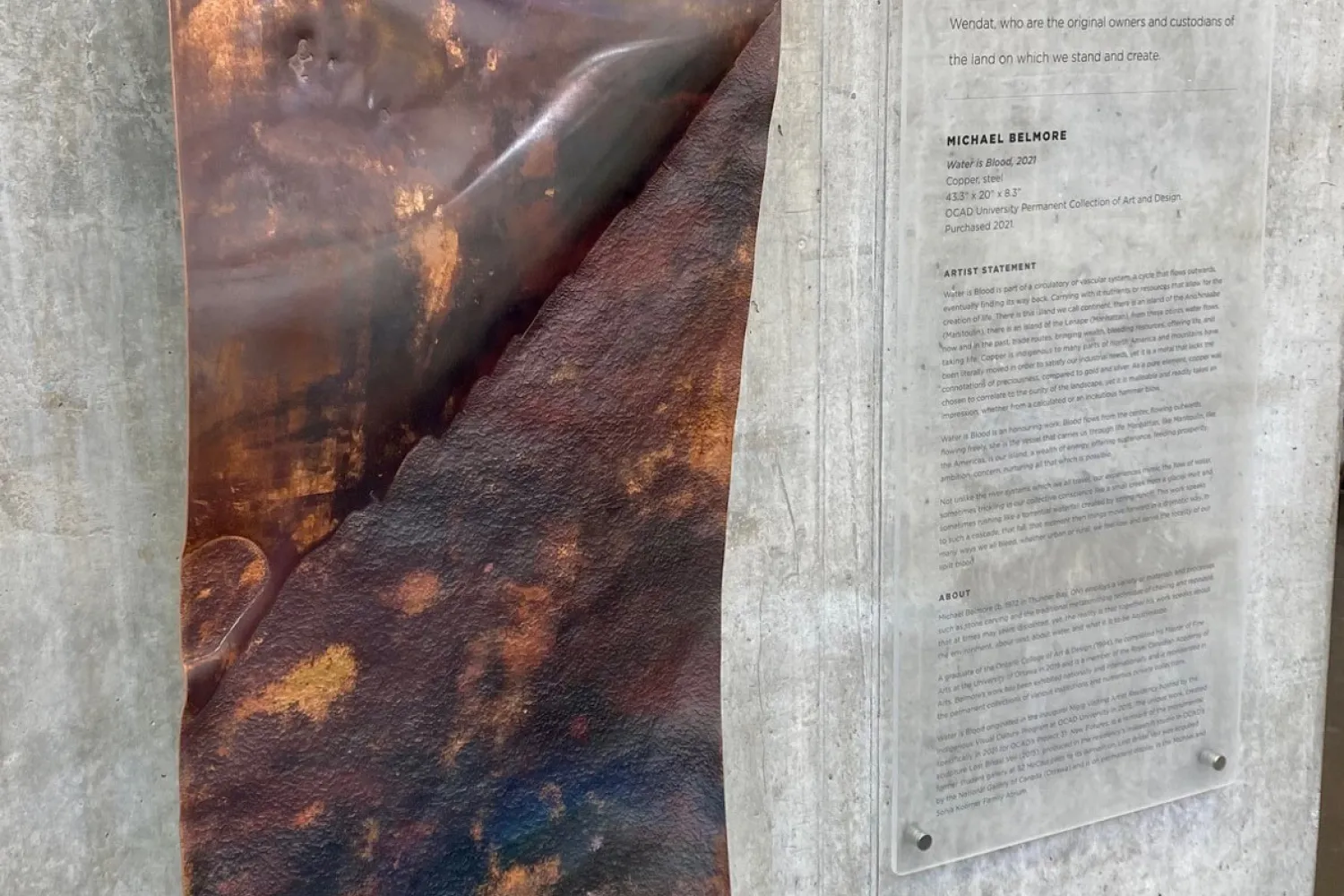
Michael Belmore
Water is Blood
(2021)
Copper, steel
43.3" x 20" x 8.3"
OCAD University Permanent Collection of Art and Design. Purchased 2021.
Artist Statement
Water is Blood is part of a circulatory or vascular system, a cycle that flows outwards, eventually finding its way back, carrying with it nutrients or resources that allow for the creation of life. There is this island we call continent, there is an island of the Anishinaabe (Manitoulin), there is an island of the Lenape (Manhattan), from these points water flows, now and in the past, trade routes, bringing wealth, bleeding resources, offering life, and taking life. Copper is indigenous to many parts of North America and mountains have been literally moved in order to satisfy our industrial needs, yet it is a metal that lacks the connotations of preciousness, compared to gold and silver. As a pure element, copper was chosen to correlate to the purity of the landscape, yet it is malleable and readily takes an impression, whether from a calculated or an incautious hammer blow.
Water is Blood is an honouring work. Blood flows from the center, flowing outwards, flowing freely, she is the vessel that carries us through life. Manhattan, like Manitoulin, like the Americas, is our island, a wealth of energy, offering sustenance, feeding prosperity, ambition, concern, nurturing all that which is possible. Not unlike the river systems which we all travel, our experiences mimic the flow of water, sometimes trickling in our collective conscience like a small creek from a glacial melt and sometimes rushing like a torrential waterfall created by spring runoff. This work speaks to such a cascade, that fall, that moment then things move forward in a dramatic way. In many ways we all bleed, whether urban or rural, we feel loss and sense the totality of our spilt blood.
About the Artist
Michael Belmore (b. 1972 in Thunder Bay, ON) employs a variety of materials and processes such as stone carving and the traditional metalsmithing technique of chasing and repoussé that at times may seem disjointed, yet the reality is that together his work speaks about the environment, about land, about water, and what it is to be Anishinaabe. A graduate of the Ontario College of Art & Design (1994), he completed his Master of Fine Arts at the University of Ottawa in 2019 and is a member of the Royal Canadian Academy of Arts. Belmore’s work has been exhibited nationally and internationally and is represented in the permanent collections of various institutions and numerous private collections.
Water is Blood originated in the inaugural Nigig Visiting Artist Residency hosted by the Indigenous Visual Culture Program at OCAD University in 2015. The unique work, created specifically in 2021 for OCAD’s Project 31: New Futures auction, is a remnant of the monumental sculpture Lost Bridal Veil (2015), produced in the residency’s makeshift studio in OCAD U’s former student gallery at 52 McCaul Street prior to its demolition. Lost Bridal Veil was acquired by the National Gallery of Canada (Ottawa) and is on permanent display in the Michael and Sonja Koerner Family Atrium.
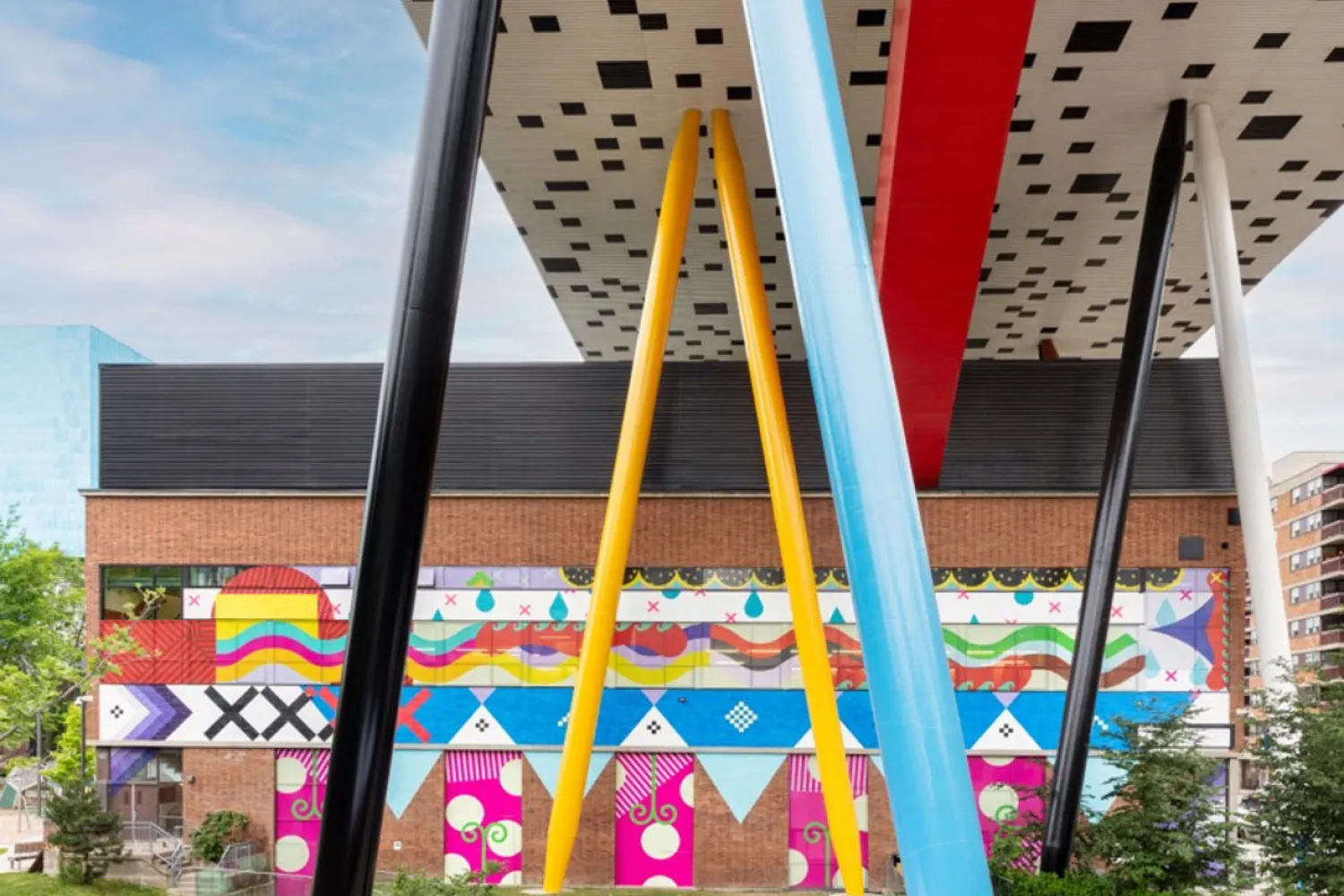
Jordan Bennett: pi'tawita'iek: we go up river (2022), south side of 100 McCaul St.
pi'tawita'iek: we go up river (2022)
Digital-print vinyl mural
144 x 45 feet
June 15, 2022, until approx. 2025 as part of ArtworxTO
Curated by Lisa Deanne Smith, Curator, Onsite Gallery
pi'tawita'iek: we go up river, on the south wall of OCAD University’s main campus, adjacent to Butterfield Park, will inaugurate the future focus of Indigenous public art at OCAD U. This new, public artwork is rooted in Bennett’s relationships with Mi’kmaq porcupine quillwork. He brings forward and reimagines their graphic patterns, bright colours, and inspiring stories. In visiting with these cultural objects Bennett connects with their visual language and furthers this visual conversation through his contemporary influences and experience. The mural received grant funding as part of ArtworxTO: Toronto's Year of Public Art 2021–2022, a year-long celebration of Toronto’s exceptional public art collection and the creative community behind it. Working closely with artists and Toronto’s arts institutions, ArtworxTO delivered major public art projects and commissions, citywide, from fall 2021 to fall 2022. Supporting local artists and new artworks that reflect Toronto's diversity, ArtworxTO created more opportunities for citizens to engage with art in their everyday lives. Visit www.artworxTO.ca for full details.
Artist Statement
My practice utilizes a variety of mediums and techniques, including but not limited to painting, sculpture, video, performance, installation and sound. These mediums allow me to fluidly explore land, language, and the act of visiting ancestral histories. By not constricting my practice to a single artistic medium, I am instead led by an idea or concept and explore what medium(s) might suit best. The use of colour in my work is very important. It allows me to express various states of time, place and season.
I often find myself working in a variety of materials for single artworks, creating uncommon combinations to create a new narrative or way to explore an old story. All aspects of my practice aim to create a welcoming environment where a dialogue between the viewer and the work can form. Each work I create allows me to further explore how I position myself within my culture and community, by analyzing Mi’kmaq visual language through the cultural connections to ancestral objects.
Having a methodology that is deeply guided by the Land of my ancestors, my ongoing work possesses qualities of familiarity that can serve as a connection for a wide range of audiences spanning culture and generation. My work, though not always directly challenging colonial perceptions of indigenous histories and presence, lends itself to discussions regarding contemporary indigenous realities within urban and rural communities.
With my ongoing series of two-dimensional work which includes works of bright blocks of acrylic paint on cradled wooden panels, murals, textiles, and carvings, I am attempting to add my voice in the reawakening and remembering of certain aspects of Mi’kmaq visual culture. Although my paintings are often viewed as abstract, they are rooted in a deep history of porcupine quillwork, which is rich in pattern through shape, colour, and composition. I take inspiration from various aspects of historical art and culture including popular culture, community and art history.
Over the past decade I have observed various pieces of quillwork in archives online, in historical texts and have had the honour of visiting them in museums nationally and Internationally. It’s through these visits and time spent with cultural objects of my home territory that I’ve begun to further explore the design, symbolism, and history of these intricate and beautiful art forms. Most of the porcupine quillwork that I have been researching exists in the form of baskets, containers, chair seat covers and wall hangings. Each work is focused on connecting and visiting with this visual language, remembering and reimagining our relations to each other, to our histories and with the land.
About the Artist
Jordan Bennett is a Mi’kmaq visual from Stephenville Crossing, Ktaqamkuk (Newfoundland). He lives and works on his ancestral territory of Mi’kma’ki in Terence Bay, Nova Scotia with his partner in life and art Amy Malbeuf. Bennett’s ongoing practice utilizes painting, sculpture, video, installation, and sound to explore land, language, the act of visiting, familial histories and challenging colonial perceptions of indigenous histories and presence with a focus on exploring Mi’kmaq and Beothuk visual culture of Ktaqamkuk.
In the past 10 years Bennett has participated in over 75 group and solo exhibitions nationally and internationally in venues such as the Smithsonian-National Museum of the American Indian, NYC; MAC-VAL, Paris; The Museum of Art and Design, NYC, NY; Museum of Contemporary Native Arts, Santa Fe, NM; Project Space Gallery, RMIT, Melbourne, AUS; The Art Gallery of Nova Scotia, The Winnipeg Art Gallery, The Power Plant, Toronto, ON; Musée d'art contemporain de Montréal, Montreal, QC; Institut du Monde Arabe, Paris, France and was one of two artists to represent Newfoundland and Labrador in the 2015 Venice Biennial at Galleria Ca’Rezzonico, Venice, Italy as part of the official Collateral Events.
Bennett has taken part in several artist in residency programs including NSCAD Lithography Workshop: Contemporary Editions, Halifax, NS in 2019, With Secrecy and Despatch, Campbelltown Art Centre, Campbelltown, Australia an Santa Fe Art Institute, Santa Fe, NM in 2015 RMIT University international Artist in Residence Program, Melbourne, Australia in 2014, Shared Lands- Centre D'artistes Vaste et Vague, Carleton-sur-Mer, Quebec and Woodland School, What Color is the Present, Visual Arts, The Banff Centre, Alberta in 2013.
He is the recipient of several awards and honours most notably one of the 2020 winners of the Sobey Art Award, long listed for the 2018, 2016 and 2015 Sobey Art Award, a Hnatyshyn Foundation REVEAL award and presented with the 2014 Newfoundland and Labrador Arts Councils Artist of the Year. Bennett holds a BFA from Sir Wilfred Grenfell College, Memorial University and an MFA from The University of British Columbia, Okanagan.
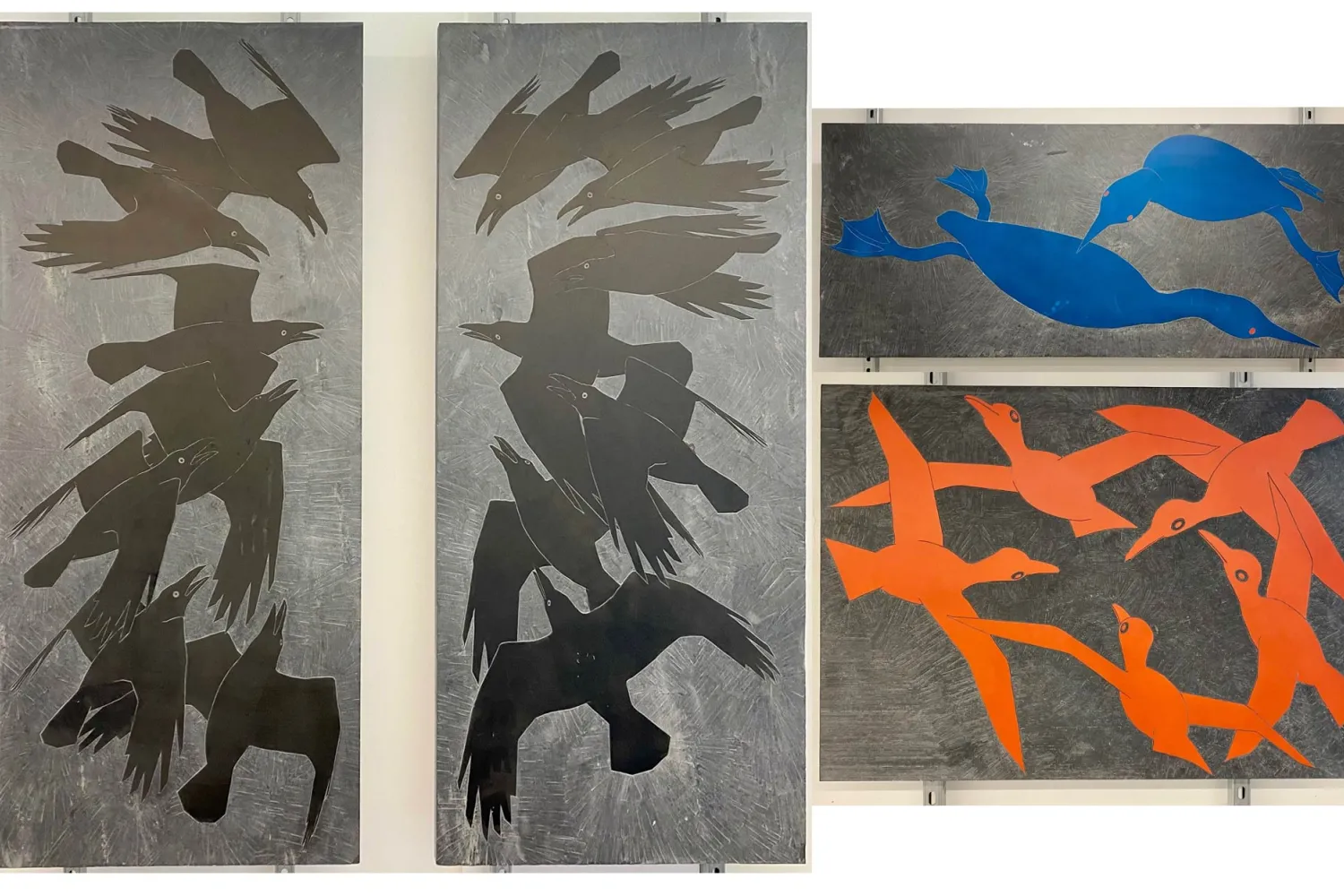
Couzyn Van Heuvelen (2021)
OCAD University Permanent Collection of Art and Design.
Commissioned from the Artist.
Artist Statement
In 2018, OCAD University commissioned artist Couzyn van Heuvelen to create permanent artwork embedding Indigenous presence within the refurbished historic George Reid House, which was the first campus for what was then the Ontario College of Art. The first building in Canada constructed specifically for art and design education, it currently houses the university’s expanded ceramics and mould making studios, and foundry.
Van Heuvelen created a series of carved stone slabs which respond to Inuit stone cuts used in printmaking across the North and highlight the associated studio processes. The installation was initiated during a residency in Qamani’tuaq (Baker Lake), Nunavut. The compositions draw on historical references, such as Henri Matisse’s The Dance (1910), reimagined through the lens of Arctic animals.
“Van Heuvelen’s work draws from the rich cultural history born from the establishment of printmaking co-ops in the North that catapulted Inuit art into global appreciation,” said Ryan Rice, then Delaney Chair in Indigenous Visual Culture at OCAD U. “The work acknowledges Inuit art history, a significant component of Canada’s national identity, and represents the unique studio process and practice that OCAD University affords.”
About the Artist
Recently longlisted for the Sobey Art Award, van Heuvelen is an Inuk artist born in Iqaluit, Nunavut, living in southern Ontario. His work explores Inuit culture and identity, new and old technologies, and personal narratives. He holds a BFA from York University and an MFA from NSCAD University.
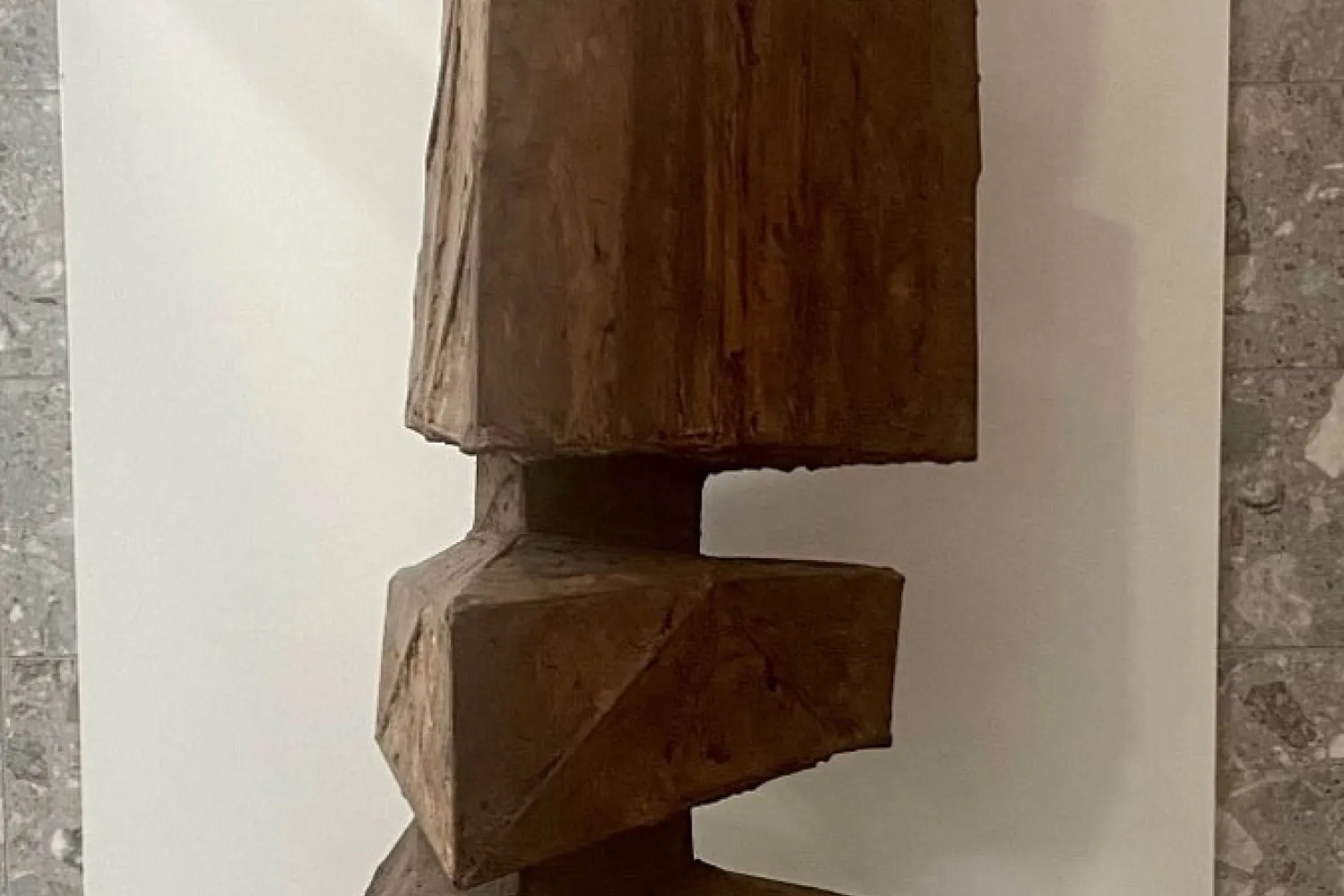
Lynn Chadwick
Trigon III
(1963-64)
Tenastic sand plaster on metal armature
H: 104.75 in.
OCAD University Permanent Collection of Art and Design. Gift of the Artist.
About the Artist
Lynn Chadwick was born in London in 1914. After taking his School Certificate at the Merchant Taylors' School, he stayed on to study drawing, watercolour and oil painting. He was then sent to Vouvray to study French. From 1933 to 1939, he worked as an architectural draughtsman in London, subsequently spending some time as a farm labourer before volunteering for the Fleet Air Arm and gaining a commission (1941-44).
After the war, he worked producing textile, furniture, and architectural designs. His first mobile sculpture, constructed from aluminum and balsa wood, was shown at a Building Trades Exhibition in 1947. He began to make sculpture and had the first of many solo exhibitions worldwide at Gimpel Fils in London in 1950. In 1953 he was one of the twelve semi-finalists in the “Unknown Political Prisoner” International Sculpture Competition, for which he was awarded an honourable mention and prize. By 1956 his reputation as a sculptor was confirmed internationally when he won the International Prize for Sculpture at the XXVIII Venice Biennale. More prizes and accolades followed as his career developed, including being awarded a CBE (Commander of the British Empire) in 1964.
During the 1950s he was prominent among the group of metal sculptors following in the steps of Henry Moore whose works, although largely abstract, carried suggestions of the human figure. Notable among Chadwick’s work at this time is The Watchers, a bronze cast from a reinforced plaster modeled upon a rigid framework. In the 1960s his work became more block-like and monumental, designed to be seen in the open.
Chadwick’s approach to sculpture was constructive and additive, rather than subtractive modelling. He first made a linear armature or skeleton onto which he applied a skin, building up the surface to a solid form. Earlier works featured a textured finish, but his later pieces have a smoother, more refined surface, and geometry replaced more organic form. His subject matter ranged from the human form, abstracted but readily recognized, to animals - general types rather than specific creatures.
Chadwick created a permanent exhibition of his work at his Gloucestershire home, Lypiatt Park, close to the foundry that cast most of his work, from monumental bronzes to miniatures in silver. During 1980s and 1990s, his work was the subject major exhibitions in Paris, London, New York, and Tokyo. He is represented in public collections in the USA, Europe, and Australia as well as in the Tate Gallery, The Victoria and Albert Museum and the Arts Council Collection of Great Britain. Lynn Chadwick passed away after a lengthy illness in 2003.
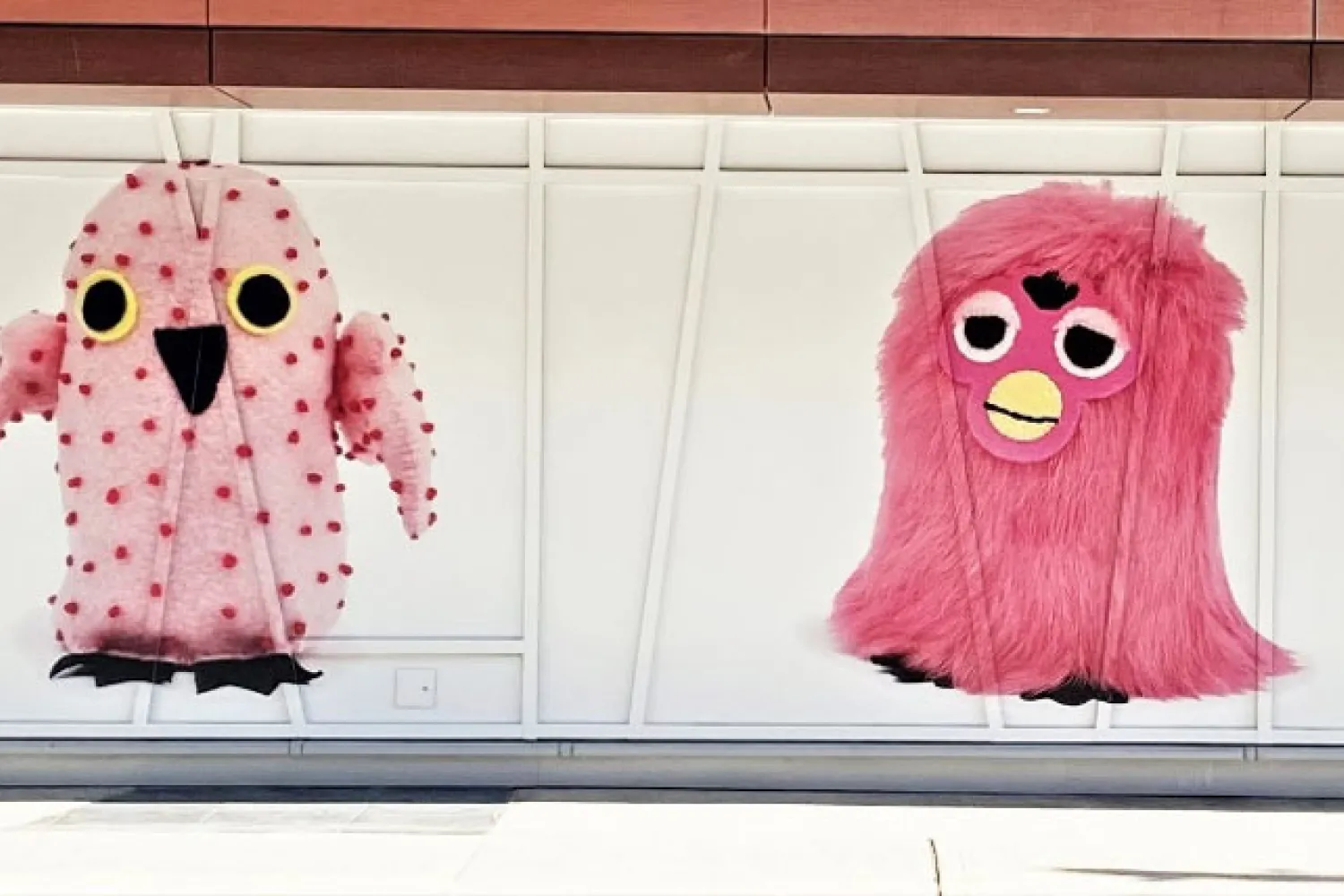
Kablusiak
Plucked Ookpik and Furby Ookpik
(2021, 2021)
Digital-print vinyl mural
On display from April to October 2022
Artist Statement
Kablusiak is an Inuvialuk artist/curator who uses Inuk ingenuity to create work in a variety of mediums including, but not limited to, lingerie, soapstone, Sharpies, bedsheets, felt, and words.
Their work explores the dis / connections between existence in Inuit diaspora while maintaining family and community ties, the impacts of colonization on Inuit gender and sexuality expressions, as well as on health, wellbeing, and the everyday. Kablusiak holds a BFA from Alberta University of Arts in Mohkinstsis, where they are currently based. Their work can be found in the collections of the Indigenous Art Centre, the Art Gallery of Alberta, and Global Affairs Visual Art Collection among others. https://norberghall.com/portfolio/kablusiak/
About the Artist
In partnership with the Inuit Art Foundation (IAF), Onsite Gallery presents Up Front, a new series of commissioned digital murals by Inuit artists. Onsite Gallery recognizes the important contributions of the Inuit art sector and is pleased to work with the IAF to support Inuit art and artists in the public realm. The Inuit Art Foundation (IAF) is the only national organization supporting Inuit artists in all medias and geographic areas. It empowers and supports Inuit artists’ self-expression and self-determination through its many platforms, including the Inuit Art Quarterly (IAQ), Canada’s largest art magazine, the IAQ Profiles, artist services, awards, scholarships, and mentorship opportunities.
For more information about public art in Toronto, visit: https://www.toronto.ca/explore-enjoy/history-art-culture/public-art/
